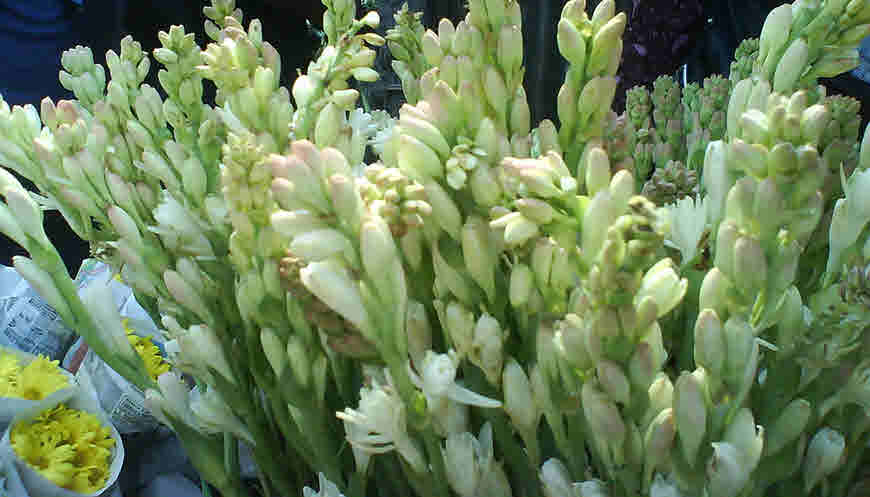Polianthes tuberosa is commonly known as Rajanigandha in India due to its night blooming fragrant flowers. It is a small bulbous herb reaching up to a height of 2-3 feet. It bears aromatic flowers and generally grown for the oranmental purpose. The waxy, white and fragrant flowers on long spikes are mostly used as cut flowers for making garlands and extracting the essential oil. There are also a few medicinal uses of Polianthes tuberosa. Flowers are used in the perfume industry and also a diuretic and emetic activity. Bulbs are used as anti-gonorrhea, diuretic, emetic and for curing rashes in the infant.

General Information
Polianthes tuberosa is night-blooming plant believed to be native to Mexico. It prefers sunny places and bloom in late summer. The bulbs of the plant are perennial and sown in fertilized soil in full sun.
Plant Description:
- Stem: A single tall stem with grass-like foliage emerges from the bulb.
- Leaves: 30 cm long, bright green leaves clustered at the base of the plant and smaller, clasping leaves along the stem.
- Flowers: The stem bears buds and flowers. Buds are little pinkish but the flowers are white.
- Part(s) used for medicinal purpose: bulbs, essential oil
- Plant type / Growth Habit: Herb
- Duration: Perennial
- Distribution: hotter parts of the world, such as Mexico or the Andes of South America, India, and other countries. Found throughout India wild as well as cultivated especially in Karnataka as an ornamental in gardens in Dehradun.
- Habitat: Hotter parts of the world
How to Grow Rajnigandha
Polianthes tuberosa is grown from its bulbs during spring season when the temperature is not so low. This plant belongs to hotter parts of the world and prefers temperature above 15°C.
- It can be grown in soil or pots.
- The bulb is placed in the soil at 2-4-inch depth. If growing in soil, the bulbs should be placed at a 6-8 inch gap.
- The soil should be rich and well drained.
- Keep the soil moist for better growth and blooming of the plant.
- During winters, the bulb can be dug, dried and stored for next summers.
Vernacular names / Synonyms
- Scientific name: Polianthes tuberosa
- Ayurvedic: Rajanigandha
- Siddha: Nilasampangi
- Manipuri: Kundalei angouba
- Urdu: Gul shabbo
- Folk: Gulcheri, Gulshabbu
- Kannada: sukandaraji
- Tamil: Neela Sampangi
- Telugu: Nelasampengi
- Marathi: Gulcheri
- Spain: Vara de San José
- Indonesia: Sedap Malam
- Hawaiian: Kupaloke
- English: Polyanthus lily
Scientific Classification
All plants are scientifically classified into main 7 levels. These levels are the Kingdom, Division, Class, Order, Family, Genus, and Species. A genus comprises of many species and the botanical name consists of Genus (uppercase) followed by Species (lowercase). Genus consists of many species which are closely related and have lots of similarities. Species is the lowest level and represents the group of the same plants.
The botanical name of Rajnigandha is Polianthes tuberosa L. tuberose. It is a Monocot and belongs to plant family Agavaceae. The word Polianthes means “many flowers” in Greek and tuberosa refers to tuberous roots of the plant.
Below is given a taxonomical classification of the plant.
- Kingdom: Plantae (comprising all living or extinct plants)
- Subkingdom: Tracheobionta (have lignified tissues or xylem for conducting water and minerals)
- Superdivision: Spermatophyta (produce seeds)
- Division: Magnoliophyta (flowering plants)
- Class: Liliopsida (flowering plant producing one cotyledon, Monocotyledons)
- Subclass: Liliidae
- Order: Liliales
- Family: Agavaceae – Century-plant family
- Genus: Polianthes L. – Polianthes P
- Species: Polianthes tuberosa L. – tuberose P
Constituents of Polianthes tuberosa
The leaves contain 9,11 Dehydrohecogenin 3- O Glucose xylose galactoside, Kameferol 3-O, α -D glucoside, Polianthoside B and C.
Medicinal Uses of Polianthes tuberosa
Polianthes tuberosa is used as folk medicine in many countries. The bulbs are used as a remedy for gonorrhea.
The bulbs are rubbed with turmeric and butter and applied to remove small red pimples of new-born children.
Bulb are also rubbed into a paste with the juice of Durva grass (Cynoclon dadylon) and applied to a swollen inflamed lymph node in the armpit or groin.
The tubers are made into a poultice and used as maturative for the formation of pus in boils and abscesses.
Boiling water (2 cups) poured over flowers and buds (1 cup) can be used externally for acne, enlarged pores, and oily skin.
Tuberose essential Oil obtained from the scented flowers is very expensive. In aromatherapy, it is used management of anxiety, stress, anger, confusion, emotional disturbances, and insomnia. The essential oil is found to be active against gram-positive and gram-negative bacteria.
Other Uses
- The plant is grown as an indoor plant.
- Flowers are used for making garlands, bouquets, etc.
- The extract obtained from plant parts is used in perfumery.
Side-effects and Warnings Polianthes tuberosa
The tuber contains lycorine alkaloid which causes vomiting on oral ingestion.
Flowers and bulbs are diuretics.